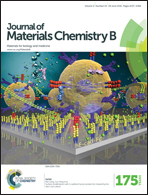Mimicking natural cell environments: design, fabrication and application of bio-chemical gradients on polymeric biomaterial substrates
Abstract
Gradients of biomolecules on synthetic, solid substrates can efficiently mimic the natural, graded variation of properties of the extracellular matrix (ECM). Such gradients represent accessible study platforms for the understanding of cellular activities, and they also provide functional supports for tissue engineering (TE). This review describes the most relevant methods to produce 2-dimensional (2D) as well as 3-dimensional (3D) gradient supports for cell manipulations, and also addresses the response of cells from different origins when seeded on these constructs. The fabrication strategies summarized encompass the combination of polymer and surface chemistries, micro- and nano-engineering construction strategies and biotechnological approaches. This multidisciplinary scheme has enabled the design and realization of diverse, synthetic supports as cellular environments, spanning from the first gradient self-assembled monolayer (SAM) to multilayers, and hybrid constructs mimicking the complexity of natural tissue environments. The standing challenge is bringing these advances in the fabrication of supports to a dynamic functioning in space and time, towards the successful imitation of the most complex bio-chemical system ever studied: our body.


 Please wait while we load your content...
Please wait while we load your content...